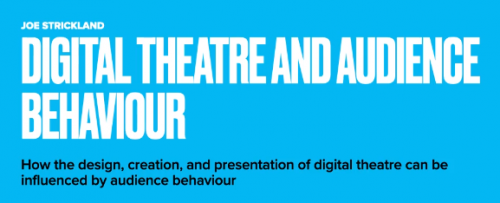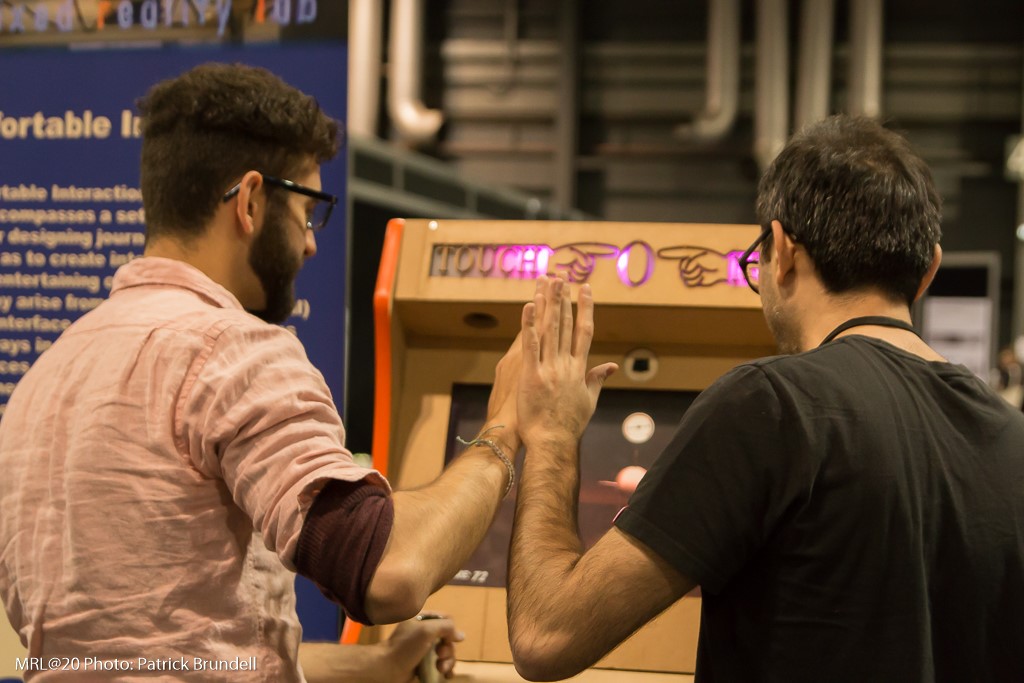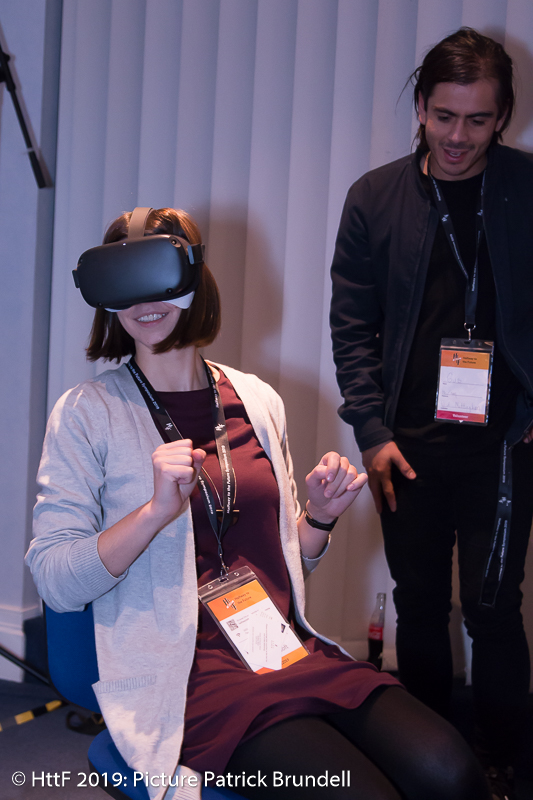
Fourth-year PhD student Joe Strickland (2017 cohort) presents eight years’ worth of outreach activity.
You can hear all about it here.

Horizon Centre for Doctoral Training Blog
To share our activity, progress and successes

Fourth-year PhD student Joe Strickland (2017 cohort) presents eight years’ worth of outreach activity.
You can hear all about it here.
post by Gustavo Berumen Salazar (2017 Cohort)
I hope you are all doing well and are well-supported during these trying times. This period has allowed me to reflect on two public engagement activities that I took part in last year. The activities involved two exhibitions where I had the opportunity to engage with the public presenting three Mixed Reality Lab (MRL) creations in two venues (MRL at CHI, 2019 and Halfway to the Future, 2019). The MRL creations that I presented were:
Touchomatic
A touch-based two-player cooperative video game, in which each player holds a sensor stick with one hand and touches the hand of the other participant to control how low and high an airship can fly. Participants have to find the sweet spot to fly the airship to collect coins and not run out of gas.
Get Screwed
A virtual reality (VR) experience that plays with notions of control, sensory misalignment, and vertigo. Participants are placed on top of a swivel chair which is rendered as a bolt by the VR interface and attempt to unscrew it by turning.
VR Playground
A VR exploration of sensory misalignment, in which people use the motion of a swing to control their navigation through the virtual world. The VR interface couples the motion with movements in the game.

In the two venues, people from different backgrounds came to try the above experiences: researchers from the field of human-computer interaction (HCI), employees of technology companies, people who don’t work in technology-related fields, and people who accompanied attendees of the conference, from adults to children, all participated in the experiences.
People were interested not only in having the experience, but also in knowing more about the technological, creative, psychological, and other components of the creations. People wanted to know what technology was used and what happened in our minds that made it possible for the creation to integrate the virtual and physical. Given that people had different levels of expertise in the area, it was necessary to give explanations according to people’s needs. In a nutshell, the response of a professor will differ from that of a child.
Overall, I found the exhibitions a challenging task. There were difficult moments when people were not satisfied with my answers, and I had to find other ways of explaining the mechanics of these VR experiences. I found it very useful to relate my explanation to common knowledge through metaphor and analogy that people could easily make a connection with them.
It was a very enriching experience given that I had the opportunity to talk about interactive experiences, VR, and motion sensing with people from different backgrounds. Those topics are very different from the area of research on which my PhD is focused, which is on design ethnography and smart products.
In general, the experience was very fulfilling. I had the opportunity to share my time exchanging ideas with people and engage in thought-provoking conversations. It has taught me valuable skills related to speaking about and explaining my research with a diverse audience. I consider some positive outcomes of my participation in these public engagement activities to be:
I hope that shortly we are able to take part in such open and diverse environments again.

post by Gustavo Berumen Salazar (2017 cohort)
Hello everyone. I hope you are doing well and are well-supported during these trying times. This period has allowed me to reflect on two public engagement activities that I took part in last year. The activities involved two exhibitions where I had the opportunity to engage with the public presenting three Mixed Reality Lab (MRL) creations in two venues (MRL at CHI, 2019 and Halfway to the Future, 2019). The MRL creations that I presented were:
A touch-based two-player cooperative video game, in which each player holds a sensor stick with one hand and touches the hand of the other participant to control how low and high an airship can fly. Participants have to find the sweet spot to fly the airship to collect coins and not run out of gas.
A virtual reality (VR) experience that plays with notions of control, sensory misalignment, and vertigo. Participants are placed on top of a swivel chair which is rendered as a bolt by the VR interface and attempt to unscrew it by turning.
A VR exploration of sensory misalignment, in which people use the motion of a swing to control their navigation through the virtual world. The VR interface couples the motion with movements in the game.

In the two venues, people from different backgrounds came to try the above experiences: researchers from the field of human-computer interaction (HCI), employees of technology companies, people who don’t work in technology-related fields, and people who accompanied attendees of the conference, from adults to children, all participated in the experiences.
People were interested not only in having the experience, but also in knowing more about the technological, creative, psychological, and other components of the creations. People wanted to know what technology was used and what happened in our minds that made it possible for the creation to integrate the virtual and physical. Given that people had different levels of expertise in the area, it was necessary to give explanations according to people’s needs. In a nutshell, the response of a professor will differ from that of a child.
Overall, I found the exhibitions a challenging task. There were difficult moments when people were not satisfied with my answers, and I had to find other ways of explaining the mechanics of these VR experiences. I found it very useful to relate my explanation to common knowledge through metaphor and analogy that people could easily make a connection with them.
It was a very enriching experience given that I had the opportunity to talk about interactive experiences, VR, and motion sensing with people from different backgrounds. Those topics are very different from the area of research on which my PhD is focused, which is on design ethnography and smart products.
In general, the experience was very fulfilling. I had the opportunity to share my time exchanging ideas with people and engage in thought-provoking conversations. It has taught me valuable skills related to speaking about and explaining my research with a diverse audience. I consider some positive outcomes of my participation in these public engagement activities to be:
I hope that shortly we are able to take part in such open and diverse environments again.

post by Siyang Song (2016 cohort)
At the end of 2019, as a Horizon CDT student at Nottingham University, I was attending a workshop (called Computer Vision for Physiological Measurement) in Seoul, South Korea. This workshop mainly focused on the research of applying recent advances in computer vision to measure the human physiological status.
This year, there were more than 50 people from company or academic institutions attending this workshop and 19 of us were giving talks to share the research we did and discussing the potential future research directions.
During this workshop, I gave a talk about how to apply state-of-the-art machine learning techniques to automatically detect emotions from people’s faces. In particular, it utilised people’s facial muscle movements to infer emotional status. This technique can be further applied to other purposes, as facial dynamics can reflect many different human statuses.
More importantly, how to apply such techniques to benefit our daily life was also discussed. For example, it can be further extended to make a quick and objective judgment about someone’s mental health, such as depression, or predict someone’s personality. Specifically, fast and automatically understanding human personality is important in employment. It can help employers to better recognise which candidates are more suitable for the job, and more willing to work in a group. Mental healthcare is another potential application. For example, while it is expensive and time-consuming to find mental health experts to diagnose mental health, such a technique can provide a cheap, quick, and objective assessment to most patients as well as provide more useful information for related doctors.
In short, such techniques have great potential to improve the business and quality of our life. For investors, it could be a good direction to invest money and time.


Since this workshop was with ICCV conference, at the end of this event, I had a great time in the banquet and had nice chats with other attendees.


post by Neeshé Khan (2018 cohort)
Last year I decided to partake in a program that engages primary school children from disadvantaged backgrounds to engage with students from the local university. This provides an opportunity for children to have positive role models or Mentors that can provide support and some sort of a roadmap to whatever they might dream to be when they grow up. I decided to do this to encourage a child to dream about a life in STEM.
As young adults, it is easy and intuitive to explore, experiment, and discover the right choices for your future career. Despite having an aptitude for STEM you might want to explore Arts or Business which is perfectly acceptable. However, when you change your mind STEM doesn’t welcome you back into the fold. There are stringent requirements for the combinations of subjects you must have and the grades you need to be able to start an undergraduate degree. If you have Physics at A-levels (anyone who has done this will tell you that Physics contains more Mathematics than A-Level Mathematics subject) it is required that you must also have Mathematics in A-levels. So if like me, a student also wants to explore economics, business studies, and a language, it means you can no longer enter an Engineering undergraduate degree regardless of your grade in Physics. However, this poses no issues for pursuing a degree in any non-science subjects as all undergraduate degrees will make you relearn the basics, and often lecturers will tell you to forget what you learnt in previous years as it’s mostly inaccurate for truly understanding the subject. Unsurprisingly, I believe that this ‘locking out’ of bright young minds for STEM fields based on ‘desirable combinations’ is in large the main contributor towards the STEM skills crisis that the western world is now facing.
But coming back to the point, I wanted to help a young child strengthen their academic STEM foundations and generate interest where they can see an exciting future in this space. In a few days, I was matched to an 11-year-old (let’s call her “Tara”) who’s interested in STEM and aspires to become a doctor.
While there are several programs available, I really enjoyed this one. It was structured, transparent, had clear expectations and outcomes, and well organised. It offered training and support for the Mentors which meant I would enjoy speaking to Megan (project co-ordinator at the venue) about what my meeting plans were or if I wanted some insights or advice.
I started off the program by providing continuity. I became a staple figure in her life which meant we would meet at a fixed schedule, for the agreed duration, at the agreed time, and follow the agenda that we had agreed in our previous meeting. I always showed up. Much like the gym, showing up (to see this little person waiting for me) meant more than half the effort was already done. We had decided to work on subjects that Tara identified she needed help with, particularly focusing on SATs (Maths, Science, and English). I also allowed Tara to decide what our meetings would look like, empowering her to be in control of our progress. This meant that while she performed very well on tests, we also reflected on what factors contributed to the mistakes and explored tools to overcome them. After a year, Tara ended up achieving one of the top scores in her school and got one of the two scholarships for a private secondary school in the area.
There were also some difficult times. I sometimes struggled to get her attention or interest. Many times this was because she had other things on her mind. Her mom was a qualified nurse from another country who couldn’t practice in the UK without an equivalence which takes time and money, two of the biggest resources for any immigrant. She ended up working two jobs in a profession outside her qualification. Tara discussed her challenges in trying to study in close quarters with her younger siblings. At a young age, she was wise beyond her years and I would often catch myself remembering how little she actually was. We put in the effort to developing skills to overcome the pressure and stress SATs bring to their young lives. We practised exercises to help retain focus in busy environments and relieve stress which included slime making and controlled breathing.
I really enjoyed discovering how the current education system uses new techniques to teach children. For instance, the way we would multiply was completely different! Thankfully our answers almost always matched! When they didn’t, I had to learn her system of understanding and convert my reasoning to fit Tara’s model so it would a) be correct/spot her mistake in her workings and b)make sense to her. I took this as a challenge and found this quite a fun exercise on most days.
Overall, I feel that I made some difference towards Tara achieving her goals and hopefully contributed towards making her STEM career aspirations a real option in her future. I would really encourage everyone to take up this as a rewarding experience to engage the future in any discipline and field you personally care about. Just be consistent and dedicate as much time as you think you can spare. Even a half-hour a week can help contribute to a young life that might need skills you might not know you have.
–originally posted on Neeshé’s blog